In a multi-part series, Comic Book Film Editor William Gatevackes will be tracing the history of comic book movies from the earliest days of the film serials to today’s big blockbusters and beyond. Along with the history lesson, Bill will be covering some of the most prominent comic book films over the years and why they were so special. We take a look at a Jade Giant’s first go around on the big screen.
I am of the firm belief that if Hulk ended with the scene where Betty meets up with the Hulk in San Francisco, we’d be talking about it as one of the best comic book films of all time. Unfortunately, it didn’t end there, and what came after makes it instead one of the most disappointing comic book films.
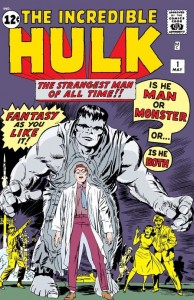 The Hulk was created by Stan Lee and Jack Kirby as a sort of Jekyll and Hyde for the Atomic Age, and Cold War version of Frankenstein. He was Bruce Banner, a nuclear physicist who was work on a gamma radiation bomb. He is caught in a bomb blast while rescuing a teenager who wanders on to the testing site and instead of killing him, the radiation turned him into a superstrong beast that would appear whenever he got angry.
The Hulk was created by Stan Lee and Jack Kirby as a sort of Jekyll and Hyde for the Atomic Age, and Cold War version of Frankenstein. He was Bruce Banner, a nuclear physicist who was work on a gamma radiation bomb. He is caught in a bomb blast while rescuing a teenager who wanders on to the testing site and instead of killing him, the radiation turned him into a superstrong beast that would appear whenever he got angry.
Initially, the concept was one of Marvel’s early failures. The Hulk’s first series only lasted six issues. But as the character appeared in cameo appearances in some of Marvel’s more popular books such as The Amazing Spider-Man and Fantastic Four there was an upswing in popularity. The character first got a co-starring strip in a comic called Tales to Astonish , eventually a series of his own.
The character reached the apex of its popularity in 1978 when the character received a live-action TV show on CBS. The Incredible Hulk starred Bill Bixby as “David” Banner and Lou Ferrigno as the Hulk. The TV show changed the origin so that Banner got his powers through genetic manipulation rather than being caught in a bomb blast.
The series lasted until 1982, with three follow-up TV-movies from 1988 to 1990. The same year the final made-for-TV movie debuted, the process of bringing the Hulk to the big screen began. Producers Avi Arad and Gale Anne Hurd began the development process, with Universal brought on board starting in 1992. Screenwriter Michael France was hired in 1994 and developed a script that had the Hulk fighting terrorists. This script was rejected and France was replaced by John Turman the next year. Turman’s series of scripts hewed closer to the comic books, with General Ross and the U.S. Military as the primary villains.
Here is where it gets convoluted. France was brought back in as writer in late-1996. However, when Joe Johnson was brought on to direct, the studio asked the projects producer, Jonathan Hensleigh, who wrote the hit Jumanji for Johnson, to reunite with the director. France was paid off and let go without ever writing a word. Unfortunately, Johnson passed on the project, and Hensleigh moved into the director’s chair. Turman was back to write a couple drafts, which were rewritten by Zak Penn. The highlight of this round of scripts was a fight between the Hulk and a group of sharks.
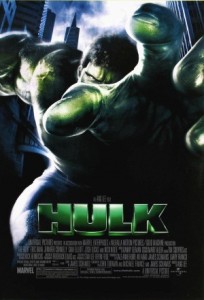 Taking that into consideration, it’s no surprise that Hensleigh took over the writing reins himself, with the Hulk fighting convicts who were altered by gamma irradiated insect DNA. Hensleigh’s rewrote the script with J. J. Abrams, Scott Alexander and Larry Karaszewski, and the project made it all the way to the casting stage before Universal, realizing that it had a $100 million picture in the hands of a first-time director, got cold feet.
Taking that into consideration, it’s no surprise that Hensleigh took over the writing reins himself, with the Hulk fighting convicts who were altered by gamma irradiated insect DNA. Hensleigh’s rewrote the script with J. J. Abrams, Scott Alexander and Larry Karaszewski, and the project made it all the way to the casting stage before Universal, realizing that it had a $100 million picture in the hands of a first-time director, got cold feet.
Exit Hensleigh in 1999 and re-enter Michael France at this point. France took another shot at the script, with rewrites from Michael Tolkin and David Hayter in 2000. Hayter brought in the Hulk’s comic book adversaries The Leader, Absorbing Man and Zzzax.
It wasn’t until 2001, after more than 10 years of development, that the Hulk film made the final leg of its journey to the big screen. That was when Ang Lee, fresh off his Oscar nomination for Crouching Tiger, Hidden Dragon, came on board. He brought James Schamus on to rework the script. This time it actually took, and the film was on the way to the big screen.
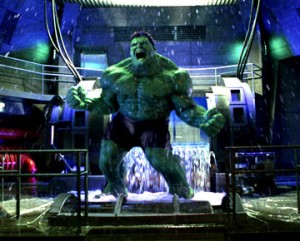 Lee cast the relative unknown Eric Bana as Bruce Banner/the Hulk and surrounded him with quality actors such as recent Oscar winner Jennifer Connelly, Oscar nominated Nick Nolte as Banner’s father, and the so-awesome-he-doesn’t-need-a-stinkin’-Oscar-nomination Sam Elliot as General Ross.
Lee cast the relative unknown Eric Bana as Bruce Banner/the Hulk and surrounded him with quality actors such as recent Oscar winner Jennifer Connelly, Oscar nominated Nick Nolte as Banner’s father, and the so-awesome-he-doesn’t-need-a-stinkin’-Oscar-nomination Sam Elliot as General Ross.
The first two thirds of the film are borderline genius. Lee seems to have had a lot of fun constructing the visual, employing split screen imagery that replicated comic book panels, which created an awesome, pop art-esque effect. The origin is once again tied to genetic engineering rather than weapons of mass destruction, but one important aspect of the comic book version’s backstory made the jump to the screen. Banner’s rage issues are tied to an abusive relationship with his father (in the film, dad tried to kill a young Bruce). This was an introduction in the comics that added layers of depth to the character.
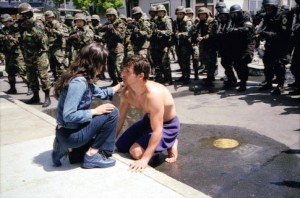 The film reaches a crescendo as the Hulk escapes from a military installation and travels from the desert to San Francisco, fighting the military all the way. It was the comic book Hulk brought to life and it was awesome. Even better, the Hulk is only stopped by the appearance of Betty in the Bay Area. Beauty soothed the savage beast, and it was an element of hope for the future. If the film ended with the shot of Bruce in Betty’s arms, it would have been one fine movie. But like I said, the film didn’t end there.
The film reaches a crescendo as the Hulk escapes from a military installation and travels from the desert to San Francisco, fighting the military all the way. It was the comic book Hulk brought to life and it was awesome. Even better, the Hulk is only stopped by the appearance of Betty in the Bay Area. Beauty soothed the savage beast, and it was an element of hope for the future. If the film ended with the shot of Bruce in Betty’s arms, it would have been one fine movie. But like I said, the film didn’t end there.
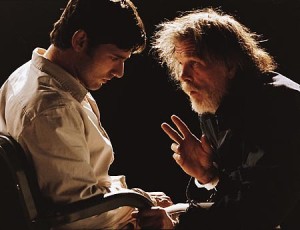 The real, awful ending, which looks like the textbook definition of tacked on, begins with Bruce’s father, David, coming to the high tech prison where Bruce is being held for a talk. Now, this is a man who was committed to a mental institution after a failed attempt to kill Bruce and a successful attempt to accidentally kill his wife. This guy, THIS GUY, gets to walk unimpeded onto a military prison so he can talk to the son, a man with rage issues that causes him to turn into a huge monster.
The real, awful ending, which looks like the textbook definition of tacked on, begins with Bruce’s father, David, coming to the high tech prison where Bruce is being held for a talk. Now, this is a man who was committed to a mental institution after a failed attempt to kill Bruce and a successful attempt to accidentally kill his wife. This guy, THIS GUY, gets to walk unimpeded onto a military prison so he can talk to the son, a man with rage issues that causes him to turn into a huge monster.
Unbeknownst to the guards, David submitted himself to a similar experience that gave his son his powers. Only this time around, the elder Banner was given the ability to absorb the physical properties of anything he touches (much like the comic’s Absorbing Man). While this is a pretty great power, David wants more. He wants to leech the power his son has, and that is the true reason for his visit.
David grabs a conveniently exposed power cable and turns himself into living electricity (much like the comic’s Zzzax) and attacks Bruce, causing him to turn into the Hulk. The two fight, Ross drops a bomb on them, David dies, the Hulk escapes.
The fact that this ending is mind-numbingly stupid is only hampered by Nolte’s hammy overacting during the scene and the absolutely horrid CGI during the battle sequence.
This ending was enough to kill the film for me. I can’t hate it, but I can’t rate it any higher than a noble failure. I wasn’t alone. Even though the film made a respectable amount of money worldwide, the next appearance of the Hulk was a reboot. We’ll be talking about that when we get to the Marvel shared universe.
Next, a film that technically isn’t based on a comic book property, but wouldn’t exist without a comic book.





RT @FilmBuffOnLine: HISTORY OF THE COMIC BOOK FILM: HULK…NOT THAT GOOD.: http://t.co/FbCYcDRUof
HISTORY OF THE COMIC BOOK FILM: HULK…NOT THAT GOOD. http://t.co/6xH3GtQ1Or